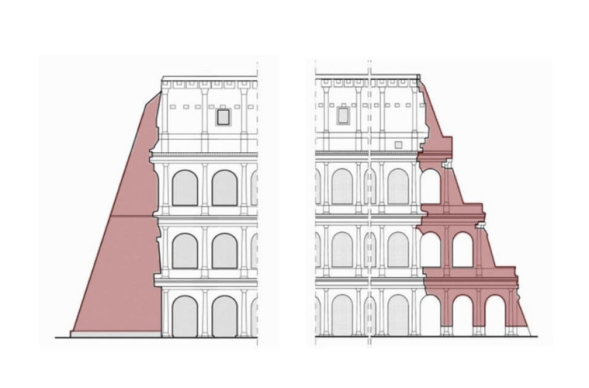Author
Zigurat Global Institute of Technology
Categories

 Figure 1: City of San Marino
If we are going to analyze the word “monument”, we will see that it has Latin roots, and stems from the word “memini” (memoria), which makes reference to the unique past heritage that does not come from the historian’s subjective construals of historical facts. Thus, the cultural heritage represent the cultural stuff in the sense that they are witnesses of history and material representatives of the joint memory.
Therefore, it is essential to bear the value of the authenticity of every architectural work in mind in any sort of intervention on the built heritage, by using technological knowledge as a response to the need of keeping the value of witnessing history.
Figure 1: City of San Marino
If we are going to analyze the word “monument”, we will see that it has Latin roots, and stems from the word “memini” (memoria), which makes reference to the unique past heritage that does not come from the historian’s subjective construals of historical facts. Thus, the cultural heritage represent the cultural stuff in the sense that they are witnesses of history and material representatives of the joint memory.
Therefore, it is essential to bear the value of the authenticity of every architectural work in mind in any sort of intervention on the built heritage, by using technological knowledge as a response to the need of keeping the value of witnessing history.
 Figure2: Intervention by Stern in 1807
On the other hand, the second intervention, carried out by the architect Valadier (1826), had the aim of fixing the same structural problem by means of imitating and re-establishing the old arches, thereby creating a community between the existing and the new project. This kind of rehabilitation favors the global picture of the monument, putting more emphasis on the symbolic and social value. (Figure 3)
Figure2: Intervention by Stern in 1807
On the other hand, the second intervention, carried out by the architect Valadier (1826), had the aim of fixing the same structural problem by means of imitating and re-establishing the old arches, thereby creating a community between the existing and the new project. This kind of rehabilitation favors the global picture of the monument, putting more emphasis on the symbolic and social value. (Figure 3)
 Figure 3: Intervention by Valadier in 1826
The same approach to restoration was also used by Viollet-le-Duc in the reconstruction of the Notre Dame Cathedral, in Paris, in the middle of the 19th century. It was called restoration “in style”. The restitution of the original elements can generate a phenomenon called “false historical” according to the terminology used in restoration. An obvious example is the St. Mark's “Campanile” in Venice.
The reflection above opens up a debate about the professionals’ stance, as well as the sensitivity towards the intervention systems on the existing heritage. In the case of the processes used in energy rehabilitation, it is pivotal to assess and know in detail the history, the construction techniques used, the geometry as well as the thermal performance of the work at hand. Otherwise, we run the risk of carrying out a project that does not comply with the authenticity and social/symbolic value of the monument, and therefore, lacks a theoretical ground.
Authors:
Luna Cara, Arquitecta Ambiental por el Politécnico de Milán. Actualmente trabaja en el equipo de arquitectos “DalCinoAdorno Architetti Associati” Es certificadora ambiental y profesora del Curso de posgrado en Arquitectura y Construcción Sostenible y del Máster Internacional en Construction Project Management de Zigurat.
Environmental Architect graduated from the Politecnico di Milano. She is currently working for the team of architects "DalCinoAdorno Architetti Associati". She is environmental certifier and Professor of the Zigurat’s Curso de posgrado en Arquitectura y Construcción Sostenible and the Máster Internacional en Construction Project Management de Zigurat.
Marta León, Product Area Manager at Zigurat - Global Institute of Technology.
Figure 3: Intervention by Valadier in 1826
The same approach to restoration was also used by Viollet-le-Duc in the reconstruction of the Notre Dame Cathedral, in Paris, in the middle of the 19th century. It was called restoration “in style”. The restitution of the original elements can generate a phenomenon called “false historical” according to the terminology used in restoration. An obvious example is the St. Mark's “Campanile” in Venice.
The reflection above opens up a debate about the professionals’ stance, as well as the sensitivity towards the intervention systems on the existing heritage. In the case of the processes used in energy rehabilitation, it is pivotal to assess and know in detail the history, the construction techniques used, the geometry as well as the thermal performance of the work at hand. Otherwise, we run the risk of carrying out a project that does not comply with the authenticity and social/symbolic value of the monument, and therefore, lacks a theoretical ground.
Authors:
Luna Cara, Arquitecta Ambiental por el Politécnico de Milán. Actualmente trabaja en el equipo de arquitectos “DalCinoAdorno Architetti Associati” Es certificadora ambiental y profesora del Curso de posgrado en Arquitectura y Construcción Sostenible y del Máster Internacional en Construction Project Management de Zigurat.
Environmental Architect graduated from the Politecnico di Milano. She is currently working for the team of architects "DalCinoAdorno Architetti Associati". She is environmental certifier and Professor of the Zigurat’s Curso de posgrado en Arquitectura y Construcción Sostenible and the Máster Internacional en Construction Project Management de Zigurat.
Marta León, Product Area Manager at Zigurat - Global Institute of Technology.

Zigurat Global Institute of Technology